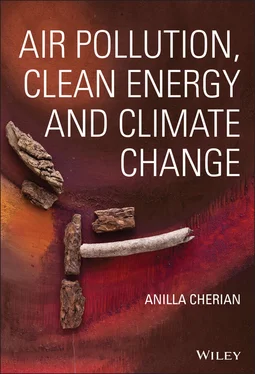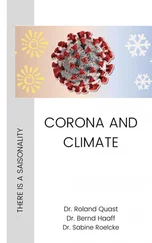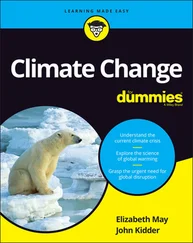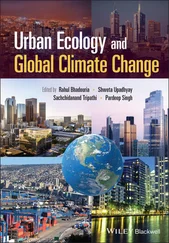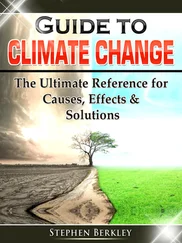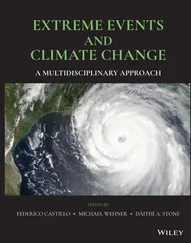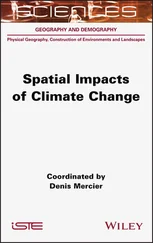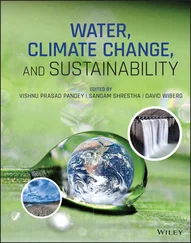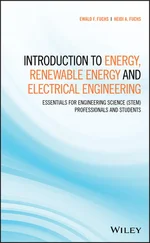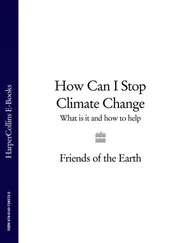Anilla Cherian - Air Pollution, Clean Energy and Climate Change
Здесь есть возможность читать онлайн «Anilla Cherian - Air Pollution, Clean Energy and Climate Change» — ознакомительный отрывок электронной книги совершенно бесплатно, а после прочтения отрывка купить полную версию. В некоторых случаях можно слушать аудио, скачать через торрент в формате fb2 и присутствует краткое содержание. Жанр: unrecognised, на английском языке. Описание произведения, (предисловие) а так же отзывы посетителей доступны на портале библиотеки ЛибКат.
- Название:Air Pollution, Clean Energy and Climate Change
- Автор:
- Жанр:
- Год:неизвестен
- ISBN:нет данных
- Рейтинг книги:5 / 5. Голосов: 1
-
Избранное:Добавить в избранное
- Отзывы:
-
Ваша оценка:
- 100
- 1
- 2
- 3
- 4
- 5
Air Pollution, Clean Energy and Climate Change: краткое содержание, описание и аннотация
Предлагаем к чтению аннотацию, описание, краткое содержание или предисловие (зависит от того, что написал сам автор книги «Air Pollution, Clean Energy and Climate Change»). Если вы не нашли необходимую информацию о книге — напишите в комментариях, мы постараемся отыскать её.
to leave no one behind
Air Pollution, Clean Energy and Climate Change
Energy and Global Climate Change
Air Pollution, Clean Energy and Climate Change — читать онлайн ознакомительный отрывок
Ниже представлен текст книги, разбитый по страницам. Система сохранения места последней прочитанной страницы, позволяет с удобством читать онлайн бесплатно книгу «Air Pollution, Clean Energy and Climate Change», без необходимости каждый раз заново искать на чём Вы остановились. Поставьте закладку, и сможете в любой момент перейти на страницу, на которой закончили чтение.
Интервал:
Закладка:
John’s relevant achievements in promoting the sustainable development concerns of developing countries that comprise the majority voice in the United Nations (UN) are a matter of public record. He served in a leadership position, often as Chairman or Co‐Chairman in more than 40 committees and organizations of the UN. He worked to secure global consensus on a wide range of international negotiations ranging from climate change to persistent organic pollutants. He was the first chair of the Clean Development Mechanism of the Kyoto Protocol and also chaired the Climate Convention’s Subsidiary Body on Implementation. He played a leading role as Co‐Chair of the Rio+20 Conference on Sustainable Development in 2012 and its historic global agreement, “ The Future We Want .” As the President of the 68 thSession of the UN General Assembly, his efforts were critical in preparing the UN for reform, the introduction of the High‐Level Political Forum, and the preliminary work in reaching consensus on global agreements on Financing for Development as well as the 2015 Paris Climate Agreement. For more than two decades at the UN, he made crucial and unprecedented contributions to sustainable development, and to almost every major multilateral environmental process and agreement within the UN system. On June 30, 2016, the UN General Assembly paid tribute to his memory and his accomplishments. And yet, despite his considerable work in the global arena, he was an inherently quiet and gentle man whose greatest gift and accomplishment was being a loving father to his sons. Always remembered and never forgotten are his acts of kindness to many in need, his calm spirit and infectious smile. May his soul, and the souls of countless others who have fought valiantly to make our shared planet a more inclusive place rest in peace.
Notes
1 * IPCC (2022) Climate Change 2022: Impacts, Adaptation and Vulnerability. Summary for Policy Makers. Geneva: IPCC. https://report.ipcc.ch/ar6wg2/pdf/IPCC_AR6_WGII_SummaryForPolicymakers.pdf
2 The views and opinions expressed in this book are solely those of the author and should not be attributed to any organization or entity.
1 Destroying Lives and Evidenced in Plain Sight: The Intertwined Crises of Climate Change, Lack of Access to Clean Energy and Air Pollution
1.1 Now or Never: The Urgency of Linked Action on Clean Air and Clean Energy in the Struggle Against Climate Change
There is no dearth of scientific and global consensus that anthropogenic or human‐induced climate change poses an existential threat to human life. In 1824, Fourier first discussed why the Earth was warmer than could be explained by solar radiation and raised the issue of heat being trapped in the atmosphere. Tyndall then offered an answer by experimentally demonstrating that greenhouse gases (GHGs) such as carbon dioxide (CO 2) can effectively absorb infrared radiation – the greenhouse effect. Building on Tyndall’s results, in 1896, Swedish scientist and Nobel Prize winner, Svante Arrhenius produced the first estimate of the sensitivity of global temperatures to increases in CO 2. By 1938, Guy Callendar demonstrated that the production of carbon dioxide by the combustion of fossil fuels was responsible for increasing the average temperature on Earth (Weart 2008; Hawkins and Jones 2013; Seidenkrantz 2018; NASA Earth Observatory website 2000). More recently, NASA, which has conducted a historic program of breakthrough research on climate science, has categorically warned that the Earth is trapping an unprecedented amount of heat, resulting in drastically warmer oceans and land temperature, with most of the warming occurring in the past 40 years and the seven most recent years being the warmest, with 2016 and 2020 tied for the warmest year on record (NASA website 2021).
Global scientific and policy consensus around climate change as a definitive and existential challenge is not a recent phenomenon (Haas 1990; Bernard and Semmler 2015). More than 16 years ago, Bill Allen, editor in chief of National Geographic , wrote that he was publishing the first of a three‐part series of stories focused on Antarctica, Alaska and Bangladesh on a topic – global climate change – that he was ‘willing to bet’ would make ‘people angry enough to stop subscribing’, but was doing so because these stories ‘cover subjects that are too important to ignore’ and show ‘the hard truth as scientists see it’. He added that he ‘can live with some cancelled memberships’ but ‘… would have a harder time looking myself in the mirror if I didn’t bring you the biggest story in geography today’ (Allen 2004). Today, that ‘biggest story in geography’ has already devastated, and is anticipated to destroy vulnerable lives spanning the world from Dhal Char, Bangladesh to New Orleans, Louisiana. Deadly forest fires, flash floods and heat waves span the globe, coral reefs are bleached, marine ecosystems are dying and low‐lying coastal cities face the escalating costs of inundation and erosion as both ocean temperatures and sea‐levels rise. But the capacity to adapt to and rebuild after calamitous climatic impacts, retreat to safer environs, and find new livelihoods is a luxury that millions who are exposed to endemic levels of fossil fuel related air pollution cannot afford.
The discomfiting truths are that the global community has long known that the morbidity and ill‐health burdens associated with climatic adversities will be borne by those who have done the least to contribute to per capita emissions of GHGs; and that the nexus between poverty, exposure to toxic levels of air pollution and inexorable climatic impacts will extract the harshest toll on the least resilient and most vulnerable among us. Back in 2007, the United Nation’s (UN) principal development agency, the UN Development Programme (UNDP) issued its Human Development Report that warned of five drivers or ‘tipping points’ by which climate change could stall and actually reverse human development: reduced agricultural productivity and increased food insecurity; heightened water stress and insecurity; rising sea levels and increased exposure to climate disasters; loss of ecosystems and biodiversity and amplified health risks, with the greatest health impacts felt in developing countries. Its warning remains prescient in this current time as the world reels from the combined effects of a global pandemic and the increasing trend of extreme climatic events. The 2007 Report was categorical about the global failure to act conclusively and decisively on climate change: ‘Failure will consign the poorest 40 percent of the world’s population—some 2.6 billion people—to a future of diminished opportunity. It will exacerbate deep inequalities within countries… In today’s world, it is the poor who are bearing the brunt of climate change. Tomorrow, it will be humanity as a whole that faces the risks that come with global warming’ (UNDP 2007, p. 2). A few paragraphs later, the Report went on to highlight that the world lacked ‘neither the financial resources nor the technological capabilities to act’ and consequently failure to act, cooperatively on climate change would ‘represent not just a failure of political imagination and leadership, but a moral failure on a scale unparalleled in history’. Here, it specifically called attention to the fact that future generations would look harshly upon those who were provided with evidence, and ‘… understood the consequences and then continued on a path that consigned millions of the world’s most vulnerable people to poverty and exposed future generations to the risk of ecological disaster’ (2007, p. 2).
It is time to acknowledge the fact that the consequences of the global failure to act conclusively on climate change have been known to, and will continue inexorably to be borne by millions living in the poorest households, communities and countries, even as global negotiations to address climate change have been occurring for decades. Within the UN context, climate change was identified more than 30 years ago as a global challenge when the UN General Assembly (UNGA) adopted a resolution sponsored by the Government of Malta, recognizing climate change as a ‘common concern of mankind’ (UNGA 1988). Intergovernmental climate negotiations have been going on for more than three decades broadly centred around two distinct but interrelated issues, both of which are associated with major technology, financing and capacity related constraints particularly for the smallest and poorest of UN member states:
Читать дальшеИнтервал:
Закладка:
Похожие книги на «Air Pollution, Clean Energy and Climate Change»
Представляем Вашему вниманию похожие книги на «Air Pollution, Clean Energy and Climate Change» списком для выбора. Мы отобрали схожую по названию и смыслу литературу в надежде предоставить читателям больше вариантов отыскать новые, интересные, ещё непрочитанные произведения.
Обсуждение, отзывы о книге «Air Pollution, Clean Energy and Climate Change» и просто собственные мнения читателей. Оставьте ваши комментарии, напишите, что Вы думаете о произведении, его смысле или главных героях. Укажите что конкретно понравилось, а что нет, и почему Вы так считаете.
